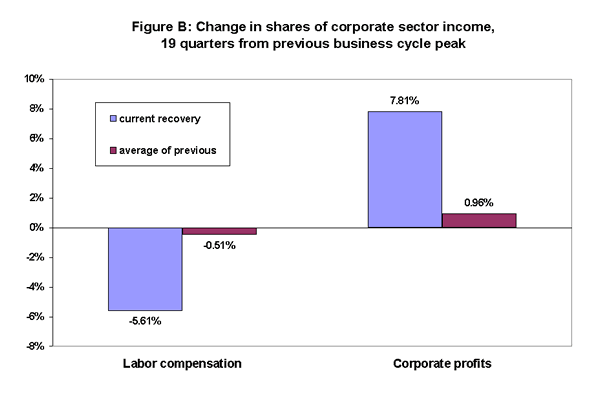See Snapshots Archive.
Snapshot for March 30, 2006.
Gross domestic income: profit growth swamps labor income
Data released by the Bureau of Economic Analysis (BEA) today show that in the fourth quarter of 2005 corporate profits claimed the largest share of gross domestic income (GDI) in 37 years.1 The last time profits claimed this large a share of GDI was in the 4th quarter of 1968 (see Figure A ). Since the last business cycle peak (the first quarter of 2001), the share of GDI going to corporate profits has risen by 3.9 percentage points, while the share going to labor compensation has fallen by 1.4 percentage points.

Within the corporate sector, where all income is classified as accruing to either capital (profits plus net interest) or labor (wages plus benefits), the picture is even starker: labor’s share of corporate income has fallen by 5.6 percentage points, and capital income’s share rose by the same amount. Corporate profits’ share rose by 7.8 percentage points, while net interest payments shrank by 2.2 percentage points. This rise in corporate profits’ share is, by far, the largest that has occurred 19 quarters after a business cycle peak since World War II, and it is about eight times as large as the average shift that has characterized previous recoveries (see Figure B ). If these shares had remained constant, labor incomes as an aggregate would be $346 billion higher today.

While productivity growth has been strong during the current recovery (averaging annual growth of 3.5%), the fruits of this growth have disproportionately flowed to profits instead of wages and benefits. This strong productivity growth provides the potential to generate broad-based increases in American living standards, but, so far corporate profits have been the only clear winner.
1. Gross Domestic Income (GDI) is analytically equivalent to gross domestic product: both measure the level of economic activity in the US economy. GDP measures the product side of the economy (the value of final sales) while GDI measures in the income side (labor compensation, profits, rent, and proprietors’ incomes). In theory GDP always exactly equals GDI, but, due to measurement error there are slight differences between the two. When assessing profits’ share, GDI is the more appropriate metric because they are measured directly through the GDI accounts.
This week’s Snapshot was written by EPI economist L. Josh Bivens.
